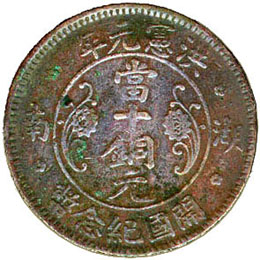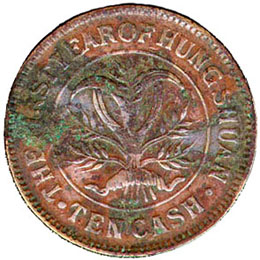| Obverse | Reverse | Description | |||||||||||||||||||||||||
 |
 | No. 322 | |||||||||||||||||||||||||
| Diam. 28 mm | |||||||||||||||||||||||||||
| Wt. 5.8 g. | Rareness D | ||||||||||||||||||||||||||
| Mint Evolution & Peculiarity | |||||||||||||||||||||||||||
This coin has a tiny bit of surface corrosion, but it does not detract from the overall appearance. This coin is in good condition. In December 1915, or the 4th year of the Republic. Yuan Shih Kai declared the reinstatement of the Empire of China and decided to rename the clendar Hung Shuan to replace the Republic beginning on the coming New Year's Day. The Hunan Mint was ordered by 湯鄉銘 Tong Hsiang Ming, General of Hunan Province to mint this copper coin. The obverse side bears the words meaning "Every copper coin equivalent to ten cash" with floral decorationss on either side, circumscribed with the 1st year of the reign of Hung Shuan and the words meaning "Coin for marking the beginning of the reign of Hung Shuan", flanked by the name of Hunan Province. In the center of the reverse side is the design of good harvest, circumscribed with the English words: "THE FIRST YEAR OF HUNG SHUAN" on the upper part and "TEN CASH" on the lower part. | |||||||||||||||||||||||||||
|
Yuan Shih Kai
Yuan Shih Kai  (1859AD-1916AD) was born in Hsiang-Cheng of Honan Province in the 9th year of the Hsien Fung reign. In 1882, he followed the Commander of Anhui Army, Wu Chang-Ch'ing went to Korea to help the Korean King training a new imperial army.
In 1884, he was recalled back to China. By the help of Li Hung-chang (1859AD-1916AD) was born in Hsiang-Cheng of Honan Province in the 9th year of the Hsien Fung reign. In 1882, he followed the Commander of Anhui Army, Wu Chang-Ch'ing went to Korea to help the Korean King training a new imperial army.
In 1884, he was recalled back to China. By the help of Li Hung-chang  , he became a 3rd-grade official in charge of training a modern army at Hsiao-Chan near Tientsin in 1895. Later, he was promoted to the position of assistant minister in charged of military training, as he pretended to support institutional reforms. In 1897, he promoted as the Governor of Shantung Province, and two years later he was promoted again to be the Governor of Chihli Province. In 1901 he promoted as the Minister of Peiyang, gradually becoming the leader of the Peiyang warlords, as he won the trust of Empress Dowager Szu Hsi. Yuan took part in the suppression of Boxers insurgent in 1900. In 1907, Yuan was summoned to the court to became a Grand Minister of the Privy Council and Minister of Foreign Affairs. After Dowager Empress died, he was stripped of all his offices in 1909. , he became a 3rd-grade official in charge of training a modern army at Hsiao-Chan near Tientsin in 1895. Later, he was promoted to the position of assistant minister in charged of military training, as he pretended to support institutional reforms. In 1897, he promoted as the Governor of Shantung Province, and two years later he was promoted again to be the Governor of Chihli Province. In 1901 he promoted as the Minister of Peiyang, gradually becoming the leader of the Peiyang warlords, as he won the trust of Empress Dowager Szu Hsi. Yuan took part in the suppression of Boxers insurgent in 1900. In 1907, Yuan was summoned to the court to became a Grand Minister of the Privy Council and Minister of Foreign Affairs. After Dowager Empress died, he was stripped of all his offices in 1909.
In 1911, when the revolutionary uprising broke out, Yuan appeared as the only man who could lead the country to peace and unity. He was the Prime Minister of the Qing Government at that time. With the support of the imperialist power, Yuan forced Emperor Hsuen Tung to give up his throne. After the unification of North and South China, Yuan Shih Kai took presidency in the first year of the Republic on 12 Feb. 1912. But Yuen attempted to be an absolute monarch of the Empire. While Yuan was in complete control of the government, Yuan mobilized public opinion to make popular the idea that constitutional monarchy could save China. In 1915, Yuan accepted the Japanese imperialists' 21 Demands which were guiding China into a colony. He preclaimed himself Emperor at Peking on 12 Dec. 1915, reign title as "Hung Shuan or Hung Hsien" which lasted only 83 days (12 Dec1915-22 Mar1916). Many provincial governor-generals did not accept Yuan as emperor. Facing strong opposition and in the absence of foreign support, Yuan was forced to abolish the monarchy in March 1916, and remained the president until he died on 6 June 1916. Later, those who had been under Yuan became warlords. These caused China then to become divided and the Warlord Era had begun. |
More about Copper Coin II
Where is the Mint Mark
of the 10 Cash TAI-CHING-TI-KUO copper coin ?